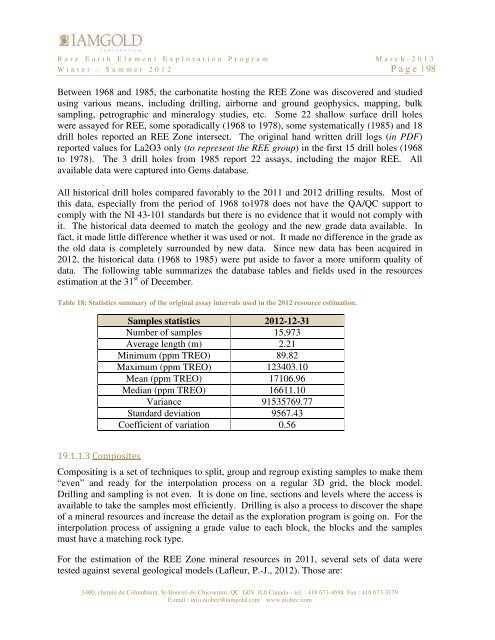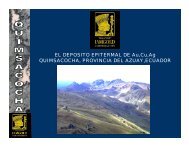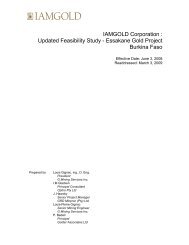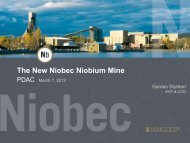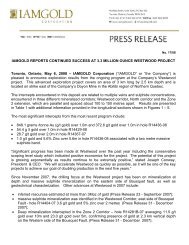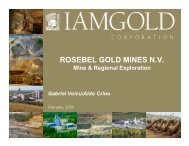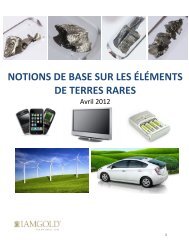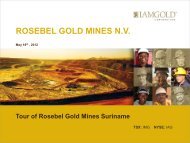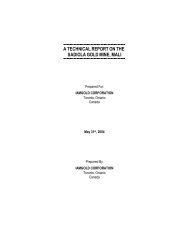NI 43-101 Technical report, Surface diamond drilling ... - Iamgold
NI 43-101 Technical report, Surface diamond drilling ... - Iamgold
NI 43-101 Technical report, Surface diamond drilling ... - Iamgold
You also want an ePaper? Increase the reach of your titles
YUMPU automatically turns print PDFs into web optimized ePapers that Google loves.
R a r e E a r t h E l e m e n t E x p l o r a t i o n P r o g r a m M a r c h - 2 0 1 3<br />
W i n t e r - S u m m e r 2 0 1 2 P a g e | 98<br />
Between 1968 and 1985, the carbonatite hosting the REE Zone was discovered and studied<br />
using various means, including <strong>drilling</strong>, airborne and ground geophysics, mapping, bulk<br />
sampling, petrographic and mineralogy studies, etc. Some 22 shallow surface drill holes<br />
were assayed for REE, some sporadically (1968 to 1978), some systematically (1985) and 18<br />
drill holes <strong>report</strong>ed an REE Zone intersect. The original hand written drill logs (in PDF)<br />
<strong>report</strong>ed values for La2O3 only (to represent the REE group) in the first 15 drill holes (1968<br />
to 1978). The 3 drill holes from 1985 <strong>report</strong> 22 assays, including the major REE. All<br />
available data were captured into Gems database.<br />
All historical drill holes compared favorably to the 2011 and 2012 <strong>drilling</strong> results. Most of<br />
this data, especially from the period of 1968 to1978 does not have the QA/QC support to<br />
comply with the <strong>NI</strong> <strong>43</strong>-<strong>101</strong> standards but there is no evidence that it would not comply with<br />
it. The historical data deemed to match the geology and the new grade data available. In<br />
fact, it made little difference whether it was used or not. It made no difference in the grade as<br />
the old data is completely surrounded by new data. Since new data has been acquired in<br />
2012, the historical data (1968 to 1985) were put aside to favor a more uniform quality of<br />
data. The following table summarizes the database tables and fields used in the resources<br />
estimation at the 31 st of December.<br />
Table 18: Statistics summary of the original assay intervals used in the 2012 resource estimation.<br />
Samples statistics 2012-12-31<br />
Number of samples 15,973<br />
Average length (m) 2.21<br />
Minimum (ppm TREO) 89.82<br />
Maximum (ppm TREO) 123403.10<br />
Mean (ppm TREO) 17106.96<br />
Median (ppm TREO) 16611.10<br />
Variance 91535769.77<br />
Standard deviation 9567.<strong>43</strong><br />
Coefficient of variation 0.56<br />
19.1.1.3 Composites<br />
Compositing is a set of techniques to split, group and regroup existing samples to make them<br />
“even” and ready for the interpolation process on a regular 3D grid, the block model.<br />
Drilling and sampling is not even. It is done on line, sections and levels where the access is<br />
available to take the samples most efficiently. Drilling is also a process to discover the shape<br />
of a mineral resources and increase the detail as the exploration program is going on. For the<br />
interpolation process of assigning a grade value to each block, the blocks and the samples<br />
must have a matching rock type.<br />
For the estimation of the REE Zone mineral resources in 2011, several sets of data were<br />
tested against several geological models (Lafleur, P.-J., 2012). Those are:<br />
3400, chemin du Columbium, St-Honoré-de-Chicoutimi, QC G0V 1L0 Canada – tel. : 418 673-4694 Fax : 418 673-3179<br />
E-mail : info.niobec@iamgold.com www.niobec.com


